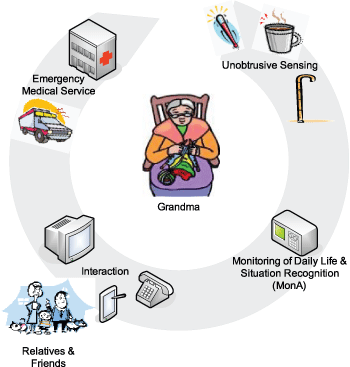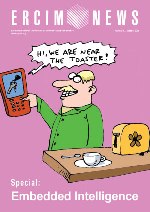by Frank Bomarius, Martin Becker and Thomas Kleinberger
Our aging societies are facing the problem that more and more elderly people want to live longer at home, in their preferred environment, despite diseases and handicaps. We have a great opportunity to tackle this major demographical problem by building embedded intelligence into systems for Ambient Assisted Living (AAL).
Demographical and social changes have an enormous effect on health care, emergency and welfare services. As the average age continues to rise, with a corresponding increase in chronic diseases, there needs to be a dramatic growth in assistance and care, resulting in even higher service costs, a decrease in quality of service, or both. While today's commercially available emergency and care equipment and health and fitness devices already cover a broad range of features, they are mostly stand-alone systems and are often just too difficult for the elderly to operate without assistance.

Our ambient intelligent care and assistance (amiCA) system will increase quality of life by using small, unobtrusive sensors which communicate wirelessly and are energy saving. We employ sensors that can be easily installed in elderly people's homes and need not be attached to the body, where possible. amiCA will reason on raw data series from individual sensors as well as on combined sensor data to derive more accurate, reliable and/or more abstract data.
By tracking the data, the daily routine of the elderly can be learned and monitored. Significant deviation from the typical routine is used as a predictor of potentially unhealthy behaviour, for example forgetting to drink or eating spoiled food due to dementia, or of dangerous situations such as being too weak to get out of bed and call for help.
By tracking vital parameters, such as indicators of dehydration, of an impending heart attack, of hypoglycaemia, or a dangerously low body temperature, potential health-induced emergency situations can be detected early on. In this way we should be able to avoid or mitigate chronic health impairment as a consequence of delayed treatment. This will effectively improve quality of life for the elderly and cut the costs of health care by shortening or avoiding hospitalisation and subsequent rehabilitation measures.
Following a staged model, amiCA will call for early assistance from family, friends, or care givers. It will provide doctors with tracks of vital parameters and thus improve the precision of diagnosis and treatment. In case of an acute emergency, such as a fall or heart attack, an automatic call to an emergency call centre will be triggered without intervention from the patient, who may not even be able to make the call.
Approach
We have identified major problem areas for the elderly by talking to care personnel, geriatricians, medical doctors and emergency centre staff and have then determined appropriate indicators that can be measured by sensors. Based on this, we set up our Ambient Assisted Living Demonstrator Laboratory (AAL Lab), which aims to come up with embedded intelligence solutions for elderly people living alone at home.
The AAL Lab will be continuously extended. In the first version, to be opened to the public in October 2006, the following scenarios are just a few of those which will be implemented:
-
Monitored Drinking - Dementia is a major reason for moving the elderly into nursing homes. Dehydration exacerbates dementia and other health problems. Reminding the elderly to drink enough is an important function. Our computerised cup measures the amount of fluids consumed each day by the person handling the cup. Potential dehydration can thus be detected.
-
Monitoring Food Quality - Eating spoiled food is another source of health problems. An RFID-based system built into a refrigerator checks for expired food and issues warnings. Food related incidents can be prevented or can be traced back to the root cause, allowing for a better treatment.
-
Location Tracking - Knowing the exact location of a person enables a whole range of location-aware services in the AAL environment, such as switching the lights on or off or activating those communication devices which are closest to the person. RFID labels embedded in the carpet of the AAL Lab are read by a walking aid, allowing the location of the person to be determined.
-
Fall Detection - A sudden fall is a strong indicator of an emergency situation and is often detected too late, sometimes hours or days later. Gyro sensors built into wrist badges, walking aids, or other body-mounted devices can detect sudden falls by a person and trigger a staged emergency reaction of the AAL system. First, the person is asked to reset the device to rule out false positives. If the person fails to react, a telephone or video-telephone connection will be initiated. Based on location-tracking information, communication devices in the appropriate room will be activated to establish a communication link between the person in trouble and the emergency call centre.
Our approach to reasoning on sensor data raises the challenge of coping with inherently unreliable and imprecise data. This is tackled by combining alternative or redundant sources. For instance, location tracking can be fed from different sensor systems (RFID, ultra-sonic, pressure, etc.).
Furthermore, the system must evolve over time, so as to adapt to the specific conditions and demands of the assisted person, as they acquire new diseases or handicaps or recover from impairment.
The central module of amiCA is MonA (Monitoring and Assistance component). In MonA, sensor data is collected and model-based reasoning is performed. The model base entails models of the assisted person, their capabilities and needs, and of the persons daily routine, including recurring medical treatments, as well as models of the living environment, for example devices and their location and capabilities.
Validation
The impact of our solution will be evaluated in several steps. The first step is the prototypical development and integration in an apartment-like AAL Lab (late 2006). The second step is integration into a nursing home and with the emergency call centre in Kaiserslautern (in 2007). The third step is validation of emergency monitoring within the 6 FP project EMERGE on a pan-European level (2006 - 2008).
This work is part of the joint research project BelAmI of Fraunhofer IESE, the University of Kaiserslautern, the University of Budapest, the University of Szeged, and the Bay Zoltan Research Foundation, Budapest. Recent achievements are described in detail in the paper: Nehmer, J.; Karshmer, A.; Becker, M.; Lamm, R.: "Living Assistance Systems" An Ambient Intelligence Approach", in Proceedings of the 28th International Conference on Software Engineering (ICSE 2006), Shanghai, China, 2006.
Links:
BelAmi: http://www.belami-project.org
IESE: http://www.iese.fraunhofer.de
University of Kaiserslautern research center on AmI website: http://www.eit.uni-kl.de/AmI/frame.html?en
Please contact:
Frank Bomarius, Martin Becker, Thomas Kleinberger, Fraunhofer IESE, Germany
Tel: +49 631 6800 1200
E-mail: {bomarius, mbecker, kleinberger}![]() iese.fraunhofer.de
iese.fraunhofer.de










